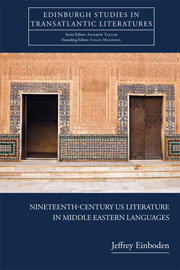Book contents
- Frontmatter
- Contents
- Acknowledgments
- Dedication
- Introduction
- Part I Scriptural Circulations
- Part II Orienting the American Romance
- Part III ‘I too am untranslatable’: Middle Eastern Leaves
- 5 The New Bible in Hebrew: Whitman and Simon Halkin
- 6 American ‘Song’ of Iraqi Exile: Whitman and Saadi Youssef
- Notes
- Bibliography
- Index
5 - The New Bible in Hebrew: Whitman and Simon Halkin
from Part III - ‘I too am untranslatable’: Middle Eastern Leaves
Published online by Cambridge University Press: 05 October 2013
- Frontmatter
- Contents
- Acknowledgments
- Dedication
- Introduction
- Part I Scriptural Circulations
- Part II Orienting the American Romance
- Part III ‘I too am untranslatable’: Middle Eastern Leaves
- 5 The New Bible in Hebrew: Whitman and Simon Halkin
- 6 American ‘Song’ of Iraqi Exile: Whitman and Saadi Youssef
- Notes
- Bibliography
- Index
Summary
The Great Construction of the New Bible
Not to be diverted from the principal object – the main life work – the Three Hundred & Sixty five – (it ought to be read in 1859. – (June '57)It is perhaps unsurprising that the above – an entry from Whitman's 1857 journals – has become a favourite with his scholarly readers. Twenty-five years ago, Herbert J. Levine could describe these cryptic jottings as ‘often quoted’, a description inevitably more accurate now than it was in 1987. Projecting his third edition of Leaves of Grass, Whitman identifies his collection's expansion and evolution as his ‘main life work’. However, it is the poet's audacity and ambition that give this entry its primary appeal, Whitman claiming the mantle of an American sacred, his Leaves proposed as a ‘New Bible’, which is projected ‘to be read in 1859’. Reconsidered in light of the complex transmissions that are our focus, Whitman's creative bravado seems especially significant, as well as especially suspect. How novel, how ‘new’, is Whitman's ‘New Bible’, exactly? To what extent is his ‘great construction’ of Leaves merely an act of reconstruction – a modern translation of scriptural precedents, rather than an original American genesis?
- Type
- Chapter
- Information
- Nineteenth-Century U.S. Literature in Middle Eastern Languages , pp. 125 - 155Publisher: Edinburgh University PressPrint publication year: 2013



